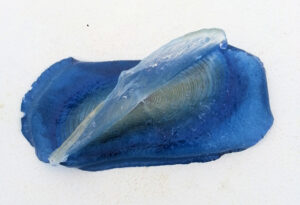By-the-Wind Sailor, Velella velella
 By-the-Wind Sailor, Velella velella. Hydrazoan collected off the ocean surface in coastal waters off Loreto, Baja California Sur, July 2016. Collection, photograph and identification courtesy of Chris Wheaton, Fullerton, California.
By-the-Wind Sailor, Velella velella. Hydrazoan collected off the ocean surface in coastal waters off Loreto, Baja California Sur, July 2016. Collection, photograph and identification courtesy of Chris Wheaton, Fullerton, California.
Phylogeny: The By-the-Wind Sailor, Velella velella (Linnaeus, 1758) is a member of the Poritidae Family of Chondronophores, that is also known as Vellella and in Mexico as veleta azul. The Velella taxon is a monospecific genus of hydrozoans. This species and the Portuguese Man-of-War look similar and are both free floating hydrozoans, but more closely related is actually the Blue Button, Porpita porpita, sharing the Class Porpitidae.
Morphology: By-the-Wind Sailors have an oval disk with a sail that is set at an angle to the longitudinal axis. They are generally blue to bluish- purple in color, though some may appear brownish due to algae living within the organism. Each apparent organism is actually a hydroid colony, floating on the surface of the water with a triangular chitinous sail. Organisms that live at the surface of the ocean like this are known as neuston. The colonies are composed of different types of polyps. The ones associated with feeding and reproduction are called gonozooids, and the protective ones are called dactylozooids. They can reach a maximum of 8.0 cm (3.1 inches) in length.
Habitat and Distribution: The By-the-Wind Sailor is found worldwide, in temperate and tropical seas. In Mexico they are a resident of all coastal waters of the Pacific Ocean.
Diet: Like other hydrozoans, the By-the-Wind Sailor is carnivorous. They have tentacles that are 1 cm (0.4 inches) in length that are equipped with nematocysts (or cnidocysts) that delivers a toxic sting to capture prey or repel predators.
Ecosystem Role: The By-the-Wind Sailor plays a key role in the pelagic ecosystem. It is preyed upon by Glaucus nudibranches and Janthina purple sails. In turn, they prey upon by appendicularians, copepods, and fish eggs.
Life Cycle: The By-the-Wind Sailor polyp form and medusa form make up a bipartite life cycle. The photograph above exhibits the most commonly seen polyp form, but this polyp will release tiny medusae during asexual reproduction. These medusae mature and reproduce sexually when egg and sperm meet to form a polyp.
Synonyms: This species was originally named Medusa Vellela, but, there are more than thirty synonyms now.